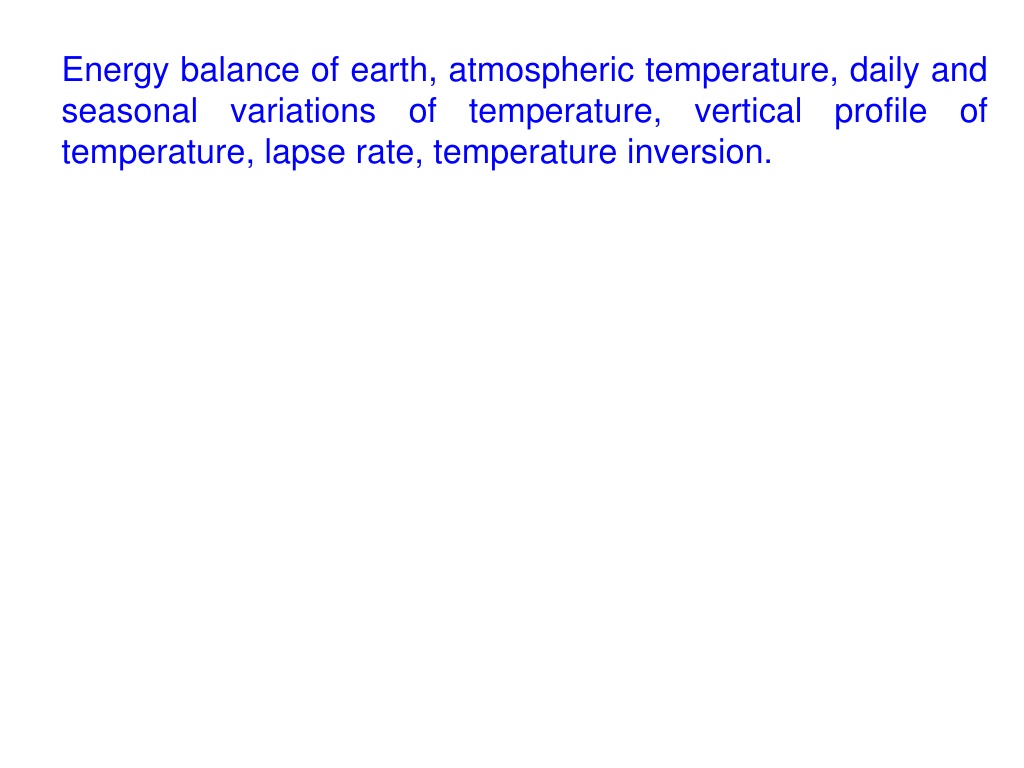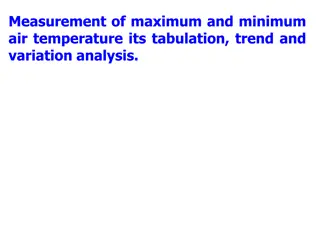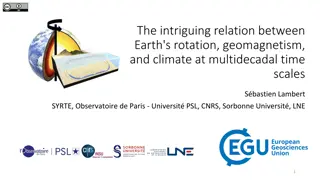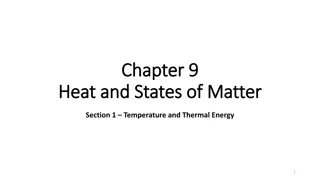Understanding Earth's Energy Balance and Temperature Variations
Earth's energy balance is crucial for maintaining atmospheric temperature and regulating daily and seasonal temperature changes. The net radiation, consisting of incoming shortwave and outgoing longwave radiation, plays a key role in this balance. Components such as sensible heat flux, latent heat of vaporization, and soil heat flux further contribute to Earth's heat balance. The diurnal variation of air temperature reflects the intricate interplay of radiation, conduction, and convection processes. Overall, these mechanisms help us understand the complex dynamics of Earth's energy distribution and temperature variations.
Download Presentation

Please find below an Image/Link to download the presentation.
The content on the website is provided AS IS for your information and personal use only. It may not be sold, licensed, or shared on other websites without obtaining consent from the author. Download presentation by click this link. If you encounter any issues during the download, it is possible that the publisher has removed the file from their server.
E N D
Presentation Transcript
Energy balance of earth, atmospheric temperature, daily and seasonal variations of temperature, vertical profile of temperature, lapse rate, temperature inversion.
Net radiation (Rn) It is the difference between incoming net shortwave (Rns) and outgoing longwave (Rnl) radiation. Rn = Rns -Rnl It is the balance between the energy absorbed, reflected and emitted by the earth's surface. Rn is normally positive during the daytime and negative during the nighttime. The total daily value for Rn is almost always positive over a period of 24 hours, except in extreme conditions at high latitudes.
Energy balance or Heat Balance on Earths surface The Rn used for various form of heat energy as : Sensible heat flux (H), Latent heat of vaporization (LE), Ground / Soil heat flux (G) Besides minor amount of Rn used for photosynthesis (Ps) and respiraton/ plant metabolic activities (M). Rn = H + LE + G + Ps + M
Schematic diagram of Diurnal variation of the components of energy balance above a well-watered transpiring vegetative surface on a cloudless day
The min. air temp. occurs at about sunrise, after which there is a constant rise till noon. The max. air temperature is recorded between 13 14 hrs, though max. solar radiation occurs around 11.30 hr. After 14hr. A steady fall in temperature occurs till sunset. The difference between max. and min. temperature is called the diurnal range of air temperature. The diurnal range of air temperature is more on clear days while cloudy weather sharply reduces daily amplitudes. The diurnal range of temperature is also influenced by soils and their coverage in addition to seasons.
Movement of heat Radiation. Stefan-Boltzman Law: Jt = T4 Jt is the total energy emmited by a body; is emissivity coefficient, is=1 for a perfect back body, is Stefan-Boltzman constant; T is the absolute temp. at the surface of a body Conduction. Convection.
Horizontal Distribution of Temperature Distribution of temperature across the latitudes over the surface of the earth is called its horizontal distribution. On maps, the horizontal distribution of temperature is commonly shown by isotherms. Isotherms are line connecting points that have an equal temperature.
Lapse Rate Change in temp with increase in altitude is lapse rate.. The lapse rate is considered positive when the temperature decreases with elevation, zero when the temperature is constant with elevation and negative when the temperature increases with elevation. The lapse rate is affected by radiation, convection, and condensation; it averages about 6.5 C / km. in the troposphere. It differs from the adiabatic lapse rate, which involves temperature changes due to the rising or sinking of an air parcel.
Factors affecting distribution of air temperature Latitude Altitude Distribution of land and water Ocean currents Prevailing winds Cloudiness Mountain barriers
Temperature inversion A temperature inversion is a layer in the atmosphere in which air temperature increases with height. An inversion is present in the lower part of a cap. The cap is a layer of relatively warm air above the inversion. Air parcels rising into this layer become cooler than the surrounding environment, which inhibits their ability to ascend. This often happens in the late afternoon/early evening (before sunset) and lingers into the next morning (after sunrise) for a few hours.
Air near the ground cools more quickly than air aloft. This is most likely when the sky is clear and the wind is light/calm. Cooling will occur the most readily in low places (such as valleys sheltered from the wind).
Significance of temperature inversion Cloud formation, precipitation and atmospheric visibility are greatly influenced by inversion phenomenon Fog formation may take place near the ground which may affect the visibility to both human beings and animals. Affects air navigation. Diurnal temperature is affected by temperature inversions. The incoming solar radiation and its conversion in to heat is affected






















